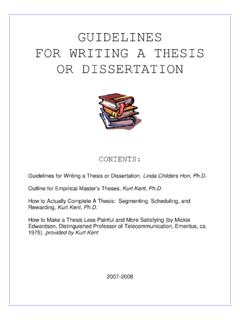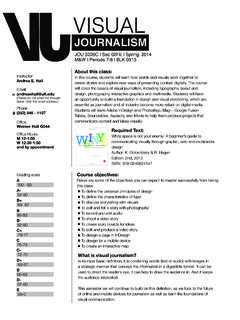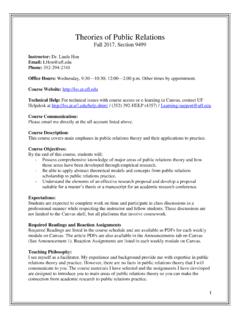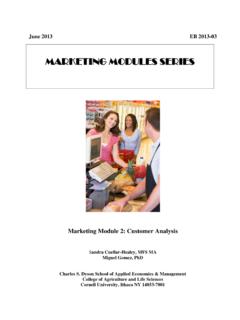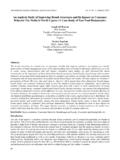Transcription of Instructor Course Overview - UF College of Journalism and ...
1 1 | Page MMC3420 consumer AND AUDIENCE ANALYTICS Instructor Sylvia Chan Olmsted, 3063 Weimer Hall 352 392 4211 Course Overview Imagine a situation like this, your supervisor approaches you with a huge data file and says, Here are some data about our consumers. Tell me what I should do. As a professional in the field of communications, media, and marketing, you will often be required to formulate strategies that create greater value for the organization, but how does one go from data to effective solutions for problems? The objectives of this Course are to introduce you to the increasing sources of consumer /audience data, the systematic process of moving from data to knowledge, and the tools for making better consumer /audience related decisions.
2 In a practical sense, how can brands use social media monitoring tools to identify opinion leaders and online influencers? How can advertisers use product usage data to segment consumers by purchasing potential? How can media outlets use audience and Twitter data to improve their content and engagement? How can online content providers and brands use web traffic and social media data to assess their popularity and user sentiment? And how can companies use market, competitor, and consumer data to make better strategic decisions? This Course aims to give you an initial road map to work through these questions. This Course fits nicely into the big data emphasis of today s learning environment as it will tackle the tools for analyzing both non structured enterprise data and structured syndicated data.
3 Topic wise, because emerging digital technologies and the popularity of social media have created massive amounts of data with the potential to reveal insights about audience/ consumer preferences and behaviors, the emphasis here will be on familiarizing you with the wide array of online audience/ consumer analytics and their relation to specific marketing/communications situations. This Course will also review leading analytics for traditional media as they are still a commonly used currency for valuating many audiences. Finally, tools for producing information about market and competition and for evaluating consumer value and characteristics are introduced to complement other major analytics. Note that this Course is not designed to train you to master the analytics/tools introduced, but to give you an Overview of a wide range of analytics/tools that are important in forming today s consumer /audience related strategies.
4 With this background, you are strongly encouraged to find resources that might help you sharpen your analytics skill sets after the introductory Course is concluded. 2 | Page There has been an unprecedented explosion of data availability due largely to advances in computing and storage technologies in the past decade. As a result, organizations can now benefit tremendously from thoughtful decisions made on the basis of intelligent data analysis. However, most organizations are data rich but information poor. They are always looking for analytic talent capable of sifting through data and translating it into useful insight to improve performance. This Course is the first step of preparing you for that journey. Course Objectives Upon successful completion of the Course , you should possess a basic understanding of the consumer and audience analytics that are valuable in most contemporary workplace.
5 The knowledge is helpful in careers related to analytics/research, social media, media business, advertising/marketing, and public relations. More specifically, the Course should enable you to: 1. Understand the characteristics, value, and use of Big Data and analytics 2. Understand the basic consumer /audience/data concepts that have analytics implications 3. Understand the characteristics, value, and use of major digital marketing/communications and media analytics 4. Understand the major analytics tools and process for developing competitive intelligence 5. Understand the basic modeling approaches/metrics for consumer /audience segmentation, targeting, positioning, and valuation 6. Understand how to best communicate the analytics results to others Course Content The Course will be divided into the following six modules: module 1: The Building Blocks of consumer and Audience Analytics This module reviews the characteristics, structure, sources, value, and use of Big Data, as well as its relationship with consumer /audience analytics and business decisions.
6 It also introduces the fundamental concepts in audience valuation, consumer behavior and decision making, the impact of digital lifestyles on these decisions/behavior, and the drivers, types, and utilities of analytics, especial for those used to make consumer segmentation, targeting, and positioning decisions. module 2: Digital Marketing and Communications Analytics This module introduces the major digital marketing and communications analytics. It reviews the characteristics, value, and use of popular web, social media, search, and mobile app analytics and discusses the functions of key digital metrics in the context of consumer /audience decisions and digital listening/influence analysis. The module also touches on the relationship between digital analytics and inbound marketing strategies.
7 3 | Page module 3: Media Audience and consumer Analytics This module introduces the terminology, data collection, and usage of major audience/ consumer information and measurement services. It also reviews relevant audience psychographic analytics and how media audience behavior and measurement have been impacted by the arrival of digital media. module 4: Competitive Intelligence Analytics This module reviews the nature and utilities of competitive intelligence programs. It introduces the data sources for assessing consumer preferences, firm performance, and market condition and competition. It also discusses the process of utilizing market based analytics to develop competitive intelligence. module 5: Modeling, Metrics, and Analytics This module reviews the utilities and main approaches for constructing models and metrics to analyze enterprise data, especially for purposes of segmentation, targeting, positioning, and evaluating consumer value.
8 module 6: From Data to Insights Communicating the Analytic Results This module introduces the process of organizing, writing, framing, and refining analytics reports, delivering effective presentations, and aligning analytic results with stakeholder needs and preferences. Course Structure Using the eLearning environment, this Course employs a mixture of contents and learning methods, including lectures, readings, online videos, spreadsheet practices, database searches, and self paced analytics overviews and exercises from a select number of analytics vendors. While recorded lectures are devoted to introducing the principles and utilities of major analytics, other contents are designed to apply the concepts in realistic settings. Note that the focus of this Course is not only to introduce you to the major analytics and tools that are useful in today s Big Data environment, but also to familiarize you with the process of translating data into useful information for better decision making in marketing communications, especially in the digital space.
9 Accordingly, various online video modules from established vendors such as Google Analytics, Hootsuite, Hubspot, and Nielsen are used to supplement the Course modules. Upon completion of some of these modules, you will be deemed certified in certain areas based on the vendors criteria. This Course will also touch on some basic consumer segmentation, targeting, and positioning modeling approaches. However, the focus of the modeling/metrics segment will not be on the theories or technical applications of the modeling process, but general introduction of the tools and their utilities. No extra credit projects will be available. All assignments are due at the specified dates. Any assignment turned in late will be assessed penalty points per calendar day.
10 Additionally, with respect to assignments, it is assumed that students will present them professionally. This means that students will 4 | Page use proper grammar, word usage, spelling, and content organization. Academic honesty is expected on all assignments and exams. Learning Material All online distributed materials associated with each Course module Grade Components 1. Big Data and consumers forum discussion ( module 1) 5% 2. Media audience assignment ( module 3) 10% 3. Competitive intelligence group assignment ( module 4) 10% 4. Excel segmentation analytics assignment ( module 5) 10% 5. Analytic report outline assignment ( module 6) 15% 6. Quizzes ( module 1 5) 30% 7. Online analytics certifications ( module 2 certification assignments) 20% Final Letter Grades and % A 93 100% A 90 B+ 87 B 83 B 80 C+ 77 C 73 C 70 D+ 67 D 63 D 60 F under 60% UF Policy University Policy on Accommodating Students with Disabilities: Students requesting accommodation for disabilities must first register with the Dean of Students Office ( ).

